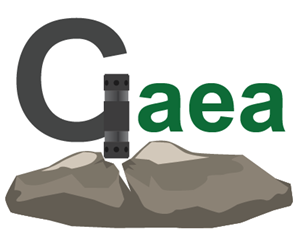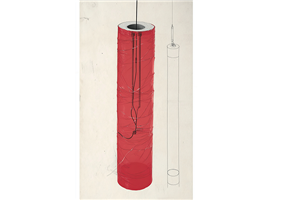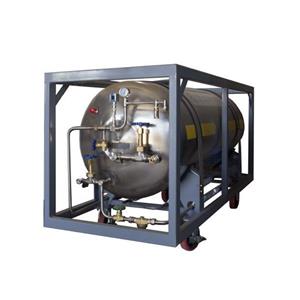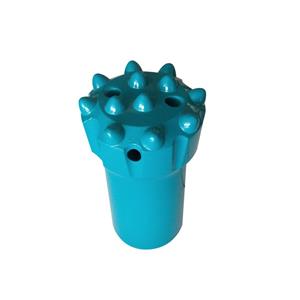The technical parameters of down-the-hole hammer drilling
Related products Link:
Air volume, wind speed and wind pressure
It is generally believed that the pressure of all compressed air is high, the drilling efficiency of the down-the-hole hammer is also high, and the service life of the drill bit is also long. The air supply volume is not only the basic condition to ensure the working of the hammer, but also an important factor to ensure the normal discharge of the powder, because in the case of dry air drilling, the effect of the powder discharge is mainly related to the speed of the upward return air. The wind speed is directly related to the air supply volume.
The air volume is determined according to the performance of the hammer used and the upward and return wind speed required to meet the well flushing. Because the cuttings have different suspension speeds in the air flow medium due to their own viscosity, density and shape, to use cuttings to effectively discharge the hole and achieve a clean bottom of the hole, it is necessary to use a higher speed than the suspension speed of the cuttings. Return wind speed. For the reverse circulation down-the-hole hammer, there is a discussion about whether such problems exist recently. For general positive circulation drilling, the return flow rate of compressed air in the gap between the drill pipe and the hole wall ring is generally recommended to be 15-30m/s. Some construction teams with complex working environments recommend that the air volume required for rock discharge often exceeds the working air volume of the down-the-hole hammer. When the diameter of the drill rod and the bit diameter are quite different, the down-the-hole hammer operates at low air pressure. Due to insufficient air volume, sufficient air flow velocity cannot be generated, and the cuttings cannot be discharged out of the hole in time and accumulate at the bottom of the hole, which is easy to occur Buried drill leads to accidents in the hole.
Therefore, when performing large-aperture DTH impact. When the ratio of the drilling diameter and the diameter of the drill pipe used is large, the air supply volume of the down-the-hole hammer cannot meet the required air volume for slag discharge, so the annular gap between the drill pipe diameter and the borehole wall with cuttings at the bottom of the hole It seems particularly important.
The key to selecting the technology of air volume, wind speed and wind pressure lies in how to master two relationships: the relationship between air energy and circulation resistance; the relationship between the upward return speed and the emptying effect; the relationship between the medium density and the drilling conditions. While solving the above relationship, corresponding technical measures should be taken, such as: increasing the air supply volume and pressure; reducing the circulation section; choosing reverse circulation hammer drilling when conditions permit; selecting the hammer model reasonably; adjusting The density of the medium, the use of gas-liquid two-phase medium circulation, such as the use of foaming agent, atomization and other aerated media. The general rule is that the higher the wind pressure, the faster the drilling speed under the same conditions. As the hole depth increases, the required pressure also increases. For example, when drilling a hole of Φ120mm, the wind pressure is 1.4Mpa when the depth is 150m, and the wind pressure is 1.7Mpa when the depth is 200m. In addition, the air pressure for drilling with air foam is about 0.18Mpa higher than that of pure air. Under the same conditions, when the hole is 200m deep, the air pressure for punching holes is 2.21Mpa, while the air pressure for drilling with pure air is only 1.7Mpa. , Different punching methods have different requirements for the capacity of equipped with air compressors. In addition, when drilling in the presence of water, the back pressure increases by 0.1Mpa to the DTH hammer for less than 10m.
In order to reduce the accumulation of cuttings, a sedimentation tube can also be installed on the upper part of the down-the-hole hammer, which can achieve results and reduce air consumption.
2. Axial pressure
From the perspective of the principle of impact rock fragmentation, the rock is mainly broken under the action of impact dynamic load. Therefore, the drilling efficiency of the down-the-hole punch mainly depends on the magnitude of the impact energy and the impact frequency, while the axial pressure is The auxiliary force that ensures the full impact of the impact energy will affect the normal drilling process if the impact energy is too large or too small. If it is too large, it will cause vibration of the drilling tool, premature wear of the drill bit, cemented carbide teeth falling, and difficulty in rotation; too small will affect the impact Effective transfer of work.
Down-the-hole hammer drilling mainly relies on pistons to impact the drill bit, rather than pressurizing the drill string to increase the drilling speed. This is a different diagram for rotary drilling with a roller cone bit. Therefore, in order to prevent violent vibration of the drill pipe, the lower limit value should be selected as much as possible. Excessive drilling pressure will damage the hammer and drill bit and reduce the drilling speed.
3. Speed
Down-the-hole hammer drilling is a slow-rotation drilling method. Reasonable speed selection is crucial to the life of the drill bit and even the cost of drilling. It is mainly related to the size of the impact energy produced by the hammer, the frequency of the hammer, the form of the drill bit and the powerless mechanical properties of the rock drilling. DTH drilling is mainly based on impact crushed rock, so there is no need for excessively fast linear speed. Too fast rotation speed is detrimental to the life of the drill bit. Especially in the abrasive rock formations, the rotation speed of the silicon block will quickly wear and chip the cutting teeth on the periphery of the bit.
If the speed is too slow, the impact of the column teeth will be repeated with the existing impact crushing points (pits), resulting in a decrease in the drilling speed. Conventionally, the harder the rock, the larger the diameter of the drill bit is, and the lower the speed is required.
When drilling in some severely fractured rock formations, sometimes an increase in speed is used to prevent sticking. But also note that sometimes the sticking is due to excessive wear of the drill bit, and increasing the speed will complicate the problem.
For down-the-hole hammer drilling, the most important bit rotation speed is to obtain effective drilling speed, balanced operation and economical bit life as general requirements.




